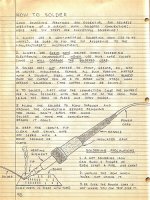Hi - I am looking into building an amp from a kit from neurochrome. I have soldered before but only in the process of building subwoofers - sloppy soldering of speaker wires to binding posts inside the cabinets. I think to build an amp that works I will need to solder correctly - would anyone be able to point me to a guide or howto that is appropriate for soldering these types of electronics? Thanks, David
Hello,
Search u tube and more, there are some good tutorials there.
Some key points to a good solder joint.
1. Make sure the parts to be connected are fairly clean.
2. Use around 750 degrees F for most work. Small common work can be done with a 15 watt iron, bigger stuff likely will require a higher wattage iron.
3. Make sure the two parts being connected have a good touching contact before adding the solder. A good mechanical connection keeps the resistance of the joint way down, makes the connection much more vibration resistant and doesn't relay on the solder conducting nearly as much.
4. Use a good quality solder with flux in it. Would suggest using lead free solder isn't worth it. Does not work as well and fumes are as bad or worse than the leaded stuff. Either way try not to inhale the fumes.
Regards
Search u tube and more, there are some good tutorials there.
Some key points to a good solder joint.
1. Make sure the parts to be connected are fairly clean.
2. Use around 750 degrees F for most work. Small common work can be done with a 15 watt iron, bigger stuff likely will require a higher wattage iron.
3. Make sure the two parts being connected have a good touching contact before adding the solder. A good mechanical connection keeps the resistance of the joint way down, makes the connection much more vibration resistant and doesn't relay on the solder conducting nearly as much.
4. Use a good quality solder with flux in it. Would suggest using lead free solder isn't worth it. Does not work as well and fumes are as bad or worse than the leaded stuff. Either way try not to inhale the fumes.
Regards
I think to build an amp that works I will need to solder correctly
Definitely. Find a junk pcb or parts and practice on that first. You need a soldering iron, not a gun.
ONLY buy 63/37 "eutectic" tin/lead solder 20 gauge, but thinner for smt, and thicker for larger parts.
Wipe the iron's tip on a damp sponge just before each joint. It should look shiny and clean. Remember
you are heating the metals to be joined, not the solder. The solder will be melted by the hot metal.
If the metal is not hot enough to melt the solder by itself, a proper joint cannot be formed.
Apply the solder to the metal just next to the iron's tip, not to the tip itself. Use only "just enough" solder.
Last edited:
Its much more efficient to feed the solder inbetween the iron and parts to the joined, as it melts on the iron, makes intimate thermal contact with the parts so they heat up quickly and start to flow the solder themselves. You want molten rosin over the parts ASAP to prevent oxidation and this techique seems to help - the rosin cores won't release any rosin till some solder melts on the iron. Rosin conducts heat better than air 
Once all the parts are wetted like this a second or two's wait allows them to heat up properly to accept the full dose of solder to complete the joint quickly and neatly.
For lead-free solder you need the sort with ~4% silver (tin/silver/copper eutectic). Its fine to work with being a eutectic. The stuff that's just tin and copper is horrible and doesn't rework.
Once all the parts are wetted like this a second or two's wait allows them to heat up properly to accept the full dose of solder to complete the joint quickly and neatly.
For lead-free solder you need the sort with ~4% silver (tin/silver/copper eutectic). Its fine to work with being a eutectic. The stuff that's just tin and copper is horrible and doesn't rework.
I did start by making a wooden board with lots of tiny nails in it, and then string thin copper wire between them, so it ended up looking like a small fence with lots of square holes in it.
Now do you just start soldering every crossing wire and keep doing it, until it's nearly automatic for you. After that, you should be really skilled in soldering.
Now do you just start soldering every crossing wire and keep doing it, until it's nearly automatic for you. After that, you should be really skilled in soldering.
do you just start soldering every crossing wire and keep doing it, until it's nearly automatic for you.
After that, you should be really skilled in soldering.
That's a start. Also try some connectors and pcbs. Every solder joint done will be somewhat different,
because of the thermal mass and the oxides present.
- Status
- This old topic is closed. If you want to reopen this topic, contact a moderator using the "Report Post" button.
- Home
- Design & Build
- Construction Tips
- First time soldering - any guides?
